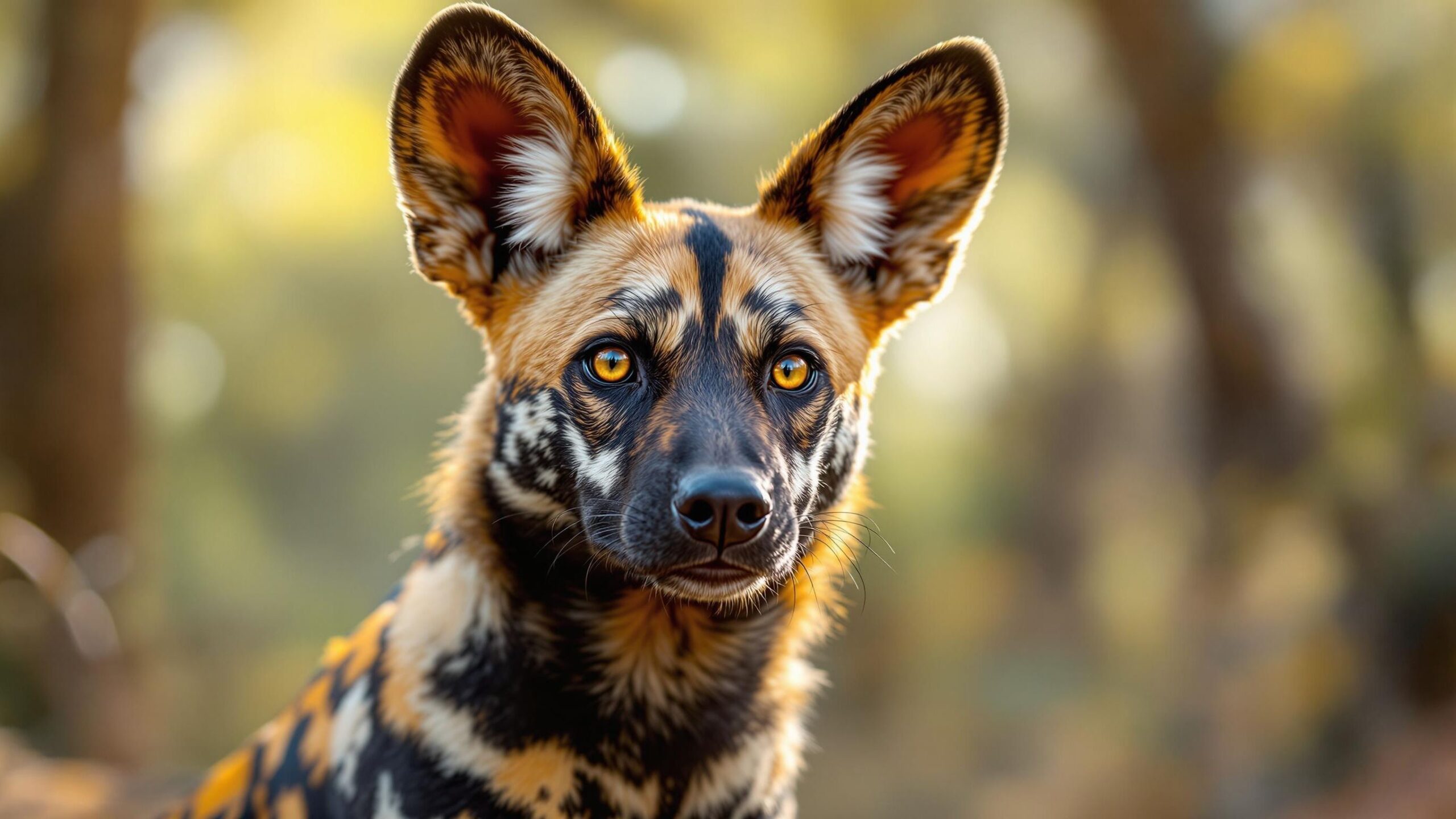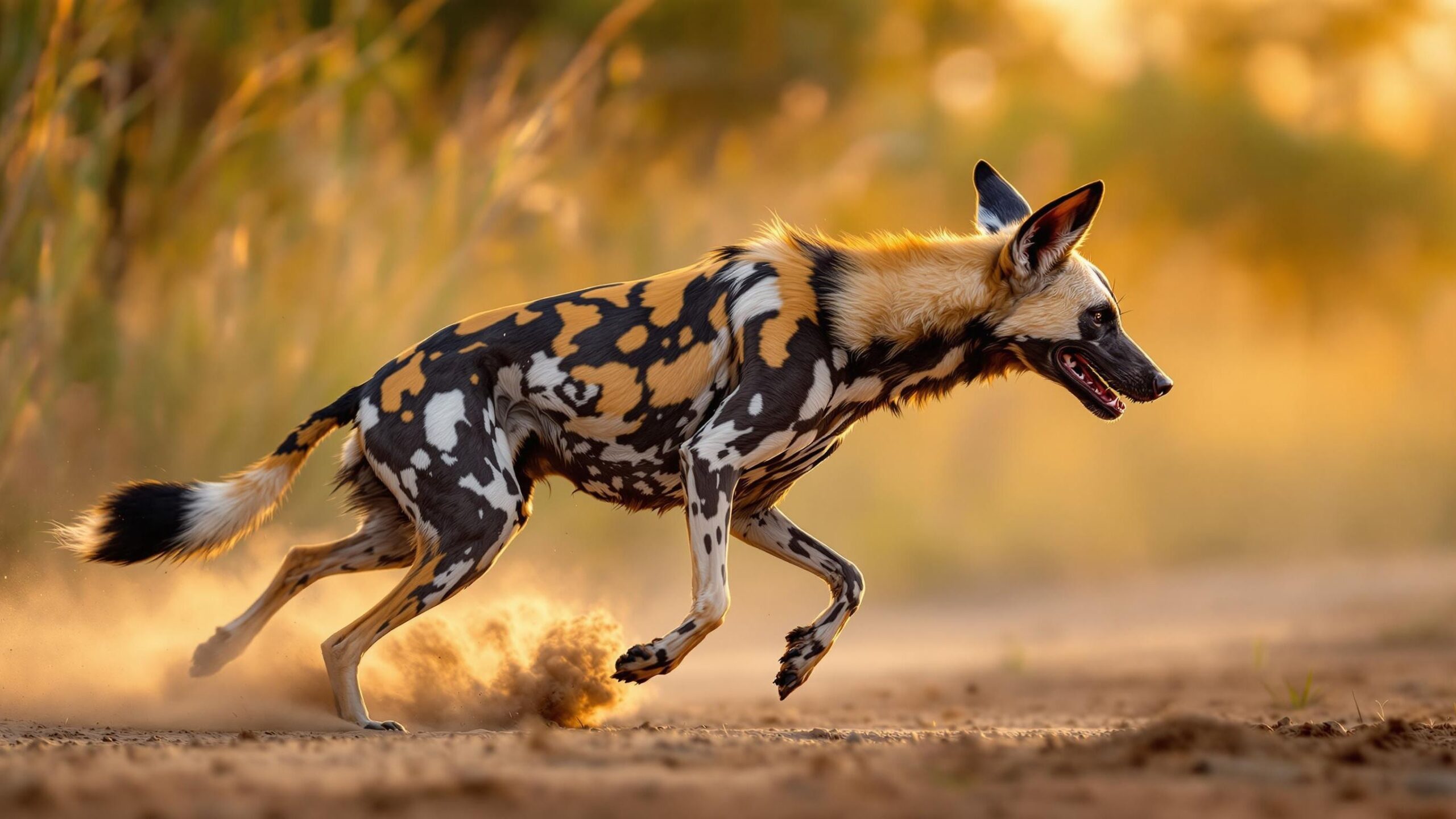The Southern African Painted Dog: Nature’s Wild Masterpiece
In the sun-drenched savannas and mopane woodlands of Southern Africa roams one of the continent’s most enigmatic and misunderstood predators: the Southern African Painted Dog (Lycaon pictus pictus). Often referred to as the African wild dog, Cape hunting dog, or simply painted wolf, this subspecies is a spectacle of nature’s design—both in its social complexity and its physical appearance. With their blotchy, multi-colored coats and large, rounded ears, Southern African painted dogs are as visually striking as they are ecologically vital.
Despite being one of Africa’s most efficient hunters, these canids face a host of challenges in the modern world. Yet their story is one of resilience, teamwork, and remarkable biological adaptation. This article offers a deep dive into the world of the Southern African Painted Dog—a tale of cooperation, wild beauty, and survival in the heart of Africa.
A Unique Predator: Taxonomy and Identity
The Southern African Painted Dog is a subspecies of the African wild dog (Lycaon pictus), which is the only species in its genus. Unlike other members of the dog family, painted dogs have only four toes on each foot (lacking the dewclaw), and they possess highly specialized dentition suited for cutting meat quickly and efficiently. Their scientific name, Lycaon pictus, translates to “painted wolf-like animal,” an apt reference to their irregular, colorful coat patterns which vary wildly between individuals, much like human fingerprints.
While painted dogs once roamed across most of sub-Saharan Africa, the Southern African subspecies is now predominantly found in countries like Botswana, Zimbabwe, Namibia, Mozambique, and South Africa. It is considered the largest and most genetically robust of the African wild dog populations.
The Coat of Many Colors: Appearance and Adaptations
No two painted dogs look alike. Their fur is mottled with patches of black, white, tan, and yellow, forming a swirling, chaotic canvas of camouflage perfectly suited for the tall grass and wooded environments they inhabit. This individuality helps pack members recognize one another at a distance, enhancing social cohesion.
Their large, rounded ears are not only distinctive but also crucial for thermoregulation and acute hearing. These ears can rotate like satellite dishes, picking up the high-pitched calls of packmates over long distances. Their long legs and lean build make them endurance hunters, capable of chasing prey over several kilometers without tiring. Physically, painted dogs are built for stamina and cooperation rather than brute strength. Weighing between 45 to 75 pounds and standing about 24 to 30 inches at the shoulder, they are relatively lightweight for apex predators. Yet what they lack in size, they more than make up for in unity and strategy.
Family First: Social Structure and Pack Life
One of the most remarkable aspects of the Southern African Painted Dog is its tightly knit social structure. Packs typically consist of a dominant breeding pair and their offspring, though extended family members may also be present. Group sizes range from as few as six to as many as twenty or more, depending on prey availability and territory size.
The social hierarchy is rigid but peaceful. Conflict within the pack is rare, as cooperation is the cornerstone of their success. Pups are given priority at kills, and injured or elderly members are fed by others. Painted dogs are incredibly vocal animals, communicating through a wide array of high-pitched chirps, twitters, and sneezes. In fact, sneezing is used as a democratic voting mechanism—when enough dogs sneeze, it signals consensus to begin a hunt. This level of cooperation is unparalleled in the canine world and plays a crucial role in the species’ survival strategy. Everything from pup-rearing to food distribution is a shared responsibility, and this unity extends beyond just the biological family.
The Art of the Hunt: Efficiency in Action
The Southern African Painted Dog is one of the most efficient predators in Africa, with a hunting success rate of over 70 percent—higher than lions and leopards. Their secret lies not in ambush or strength but in endurance, teamwork, and coordination.
Painted dogs prefer to hunt in the early morning or late afternoon when temperatures are cooler. Prey includes medium-sized ungulates like impalas, kudu, and wildebeest calves. Once a target is identified, the pack fans out to flush it from cover and initiates a long-distance chase. During this pursuit, individual dogs take turns leading and nipping at the prey to wear it down. Once caught, the animal is quickly dismembered and consumed, often in under 15 minutes. This rapid consumption is essential to avoid losing the kill to larger scavengers such as hyenas or lions. The pack then regroups, often returning to feed pups or regurgitating meat for those who remained behind.

Habitats and Range: Where the Wild Things Roam
Southern African Painted Dogs thrive in savannas, open plains, and lightly wooded areas. Their territories can span hundreds of square kilometers, and they are always on the move—rarely staying in one place for long unless denning with pups.
Key strongholds for this subspecies include:
-
Okavango Delta, Botswana – Perhaps the most famous stronghold, offering ideal habitat and relatively low human interference.
-
Hwange National Park, Zimbabwe – Home to one of the most intensively studied painted dog populations.
-
Kruger National Park, South Africa – Though numbers are small, they are part of a broader conservation corridor.
-
Gonarezhou National Park, Zimbabwe/Mozambique border – An emerging safe zone due to transboundary conservation efforts.
Although these areas offer some protection, human encroachment, expanding settlements, and road networks continue to fragment and shrink their range.
Reproduction and Pup Rearing: A Communal Affair
Breeding season typically occurs between April and July. Only the alpha pair reproduces, a strategy that minimizes conflict and maximizes pack support for the offspring. After a gestation period of approximately 70 days, the alpha female gives birth to a litter of 8 to 12 pups—among the largest litters in the canine world.
The pups are born in a den, often a former aardvark burrow, and remain there for the first three months of life. During this time, the entire pack rallies around the new generation, bringing back food and guarding them from predators. Older siblings often act as babysitters while the adults hunt. This communal investment in the next generation reflects the painted dog’s deeply rooted cooperative ethos. As the pups grow, they begin joining the pack on short hunts, learning the complex choreography that defines their hunting strategy.
Intelligence, Communication, and Culture
The Southern African Painted Dog is not just a skilled hunter but also a remarkably intelligent and emotionally complex animal. Studies have shown that painted dogs display empathy, mourning behavior, and even what can be described as a form of “cultural knowledge” passed between generations.
Vocalizations are incredibly diverse, ranging from rallying calls to submission whimpers and directional alerts during hunts. Their communication system is so nuanced that conservationists are currently exploring ways to use recordings of painted dog calls to lure animals away from danger zones, such as roads or snares. These dogs also exhibit unique cultural rituals. Before a hunt, the pack engages in a high-energy greeting ceremony that includes body rubbing, jumping, and vocalizing. This serves to strengthen social bonds and psych up the team before a chase.
Natural Threats and Predators
While adults have few natural predators, lion attacks are a significant cause of mortality. Lions tend to view painted dogs as competition and will kill them whenever possible, though they rarely eat them. Hyenas also pose a threat, often stealing kills or attacking isolated individuals.
Pups face greater dangers. Aside from lions and hyenas, they may fall prey to leopards, large birds of prey, or even starvation if the pack is unable to hunt successfully. This vulnerability underscores the importance of large, cohesive packs and secure denning sites during the breeding season. Disease is another major threat. Rabies and canine distemper, often contracted from domestic dogs near human settlements, have devastated entire populations in certain areas. These diseases can spread quickly through a tightly bonded pack, making immunization campaigns in buffer zones crucial.
Human Conflict and Conservation Challenges
Despite their charisma and ecological importance, painted dogs are among the most endangered carnivores in Africa. It is estimated that fewer than 7,000 individuals remain in the wild, with the Southern African subspecies comprising the bulk of this number.
The primary threats are:
-
Habitat loss due to agriculture, mining, and human settlement
-
Vehicle collisions on expanding road networks
-
Snaring and poaching, often unintended but fatal
-
Disease transmission from domestic animals
-
Persecution, due to outdated beliefs about livestock predation
Yet much of the fear and misunderstanding surrounding painted dogs is unfounded. Studies have shown they rarely kill livestock and prefer wild prey. Education campaigns have made headway in correcting these myths, especially in communities living near protected areas.

A Brighter Future: Hope on the Horizon
Though their situation is precarious, the Southern African Painted Dog has not been forgotten. Conservation programs like the Painted Dog Conservation Project in Zimbabwe, the African Wildlife Conservation Fund, and collaborative efforts across the Kavango-Zambezi Transfrontier Conservation Area are helping stabilize and grow local populations.
Key strategies include:
-
Anti-poaching patrols and removal of snares
-
Vaccination programs to prevent disease outbreaks
-
Wildlife corridors that connect fragmented populations
-
Community outreach and education, especially among children
-
Eco-tourism initiatives that showcase painted dogs as a tourism draw
Some programs even use GPS collars and radio telemetry to track pack movements in real time, providing invaluable data while enabling fast responses to emerging threats.
Public perception is also slowly shifting. Once demonized or ignored, painted dogs are becoming a symbol of ecological interconnectedness and the power of community—both in their social structures and in the human conservation networks fighting for their future.
Why Painted Dogs Matter
Painted dogs are more than just another predator. They are vital regulators of prey populations, keeping ecosystems in balance. Their presence often indicates a healthy, functioning habitat. Ecologists refer to them as an “umbrella species”—protecting them and their habitat ensures the conservation of countless other species. But perhaps what makes them most special is their social soul. Few wild animals display the level of altruism, empathy, and loyalty that define the Southern African Painted Dog. They are, in a sense, nature’s reminder of the power of unity, resilience, and compassion—even in the wildest of places.
Guardians of the Wild Mosaic
The Southern African Painted Dog is a creature of contrasts—beautiful yet persecuted, fierce yet nurturing, rare yet resilient. As they move silently across the golden landscapes of Southern Africa, they carry with them an ancient story—of survival, community, and the complex tapestry of life. To know them is to be inspired. And perhaps, through knowledge and respect, we can ensure that these painted ghosts of the savanna continue to run wild beneath African skies for generations to come.

